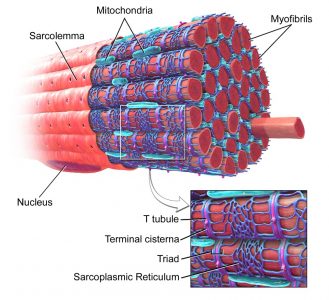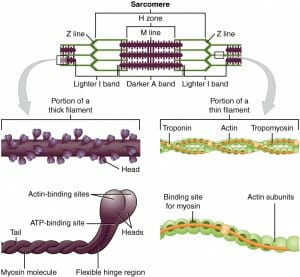Muscle Cell Definition
A muscle cell, known technically as a myocyte, is a specialized animal cell which can shorten its length using a series of motor proteins specially arranged within the cell. While several associated proteins help, actin and myosin form thick and thin filaments which slide past each other to contract small units of a muscle cell. These units are called sarcomeres, and many of them run end-to-end within a larger fiber called a myofibril. A single muscle cell contains many nuclei, which are pressed against the cell membrane. A muscle cell is a long cell compared to other forms of cells, and many muscle cells connect together to form the long fibers found in muscle tissue.
Structure of a Muscle Cell
As seen in the image below, a muscle cell is a compact bundle of many myofibrils. Each myofibril is made of many sarcomeres bundled together and attached end-to-end. A specialized form of the endoplasmic reticulum, known as the sarcoplasmic reticulum, extends in and around these myofibril bundles. The sarcoplasmic reticulum (SR for short) concentrates a chemical needed for the muscle cells to contract, and is activated by signals from nerve cells. The signals travel through the transverse tubules (T tubules in the picture below) after being received from a nerve and activates the SR. Mitochondria are densely packed throughout muscle cells, to provide a constant flow of ATP. The entire cell is covered in a specialized cell membrane known as the sarcolemma. The sarcolemma has special opening which allow nerve impulses to be passed into transverse tubules.
Below is a blown up view of each sarcomere. Each sarcomere is made primarily from thick and thin filaments. Thick filaments are made from repeating units of a protein known as myosin. Myosin has small heads on it which can bind to an actin filament. Repeating units of the protein actin make up the thin filament. Actin is supported by a number of accessory proteins which give the strands stability and allow the muscle to be controlled by nerve impulses.
The actin filaments are supported on each end by specialized proteins. The CapZ protein holds actin to the Z plate, while tropomodulin connects to the end of each actin filament. Nebulin connects CapZ to tropomodulin, providing a structural framework to hold the actin filaments rigid. Another large protein, titin, connects the Z plates together and prevents the sarcomere from being overstretched when it is not contracting. These proteins cannot be seen in the image below.
Actin is covered by two additional proteins, troponin and tropomyosin. Troponin is the small yellow ball in the image below, while tropomyosin is the thread-like protein which follows the actin filament. The myosin proteins can also be seen. The heads extend upward from a thick fiber made of many myosin tails wound together.
Function of a Muscle Cell
To activate a muscle, the brain sends an impulse down a nerve. The nerve impulse travels down the nerve cells to the neuromuscular junction, where a nerve cell meets a muscle cell. The impulse is transferred to the nerve cell and travels down specialized canals in the sarcolemma to reach the transverse tubules. The energy in the transverse tubules causes the SR to release of the Ca2+ it has built up, flooding the cytoplasm with calcium. The Ca2+ has a special effect on the proteins associated with actin.
Troponin, when not in the presence of Ca2+, will bind to tropomyosin and cause it to cover the myosin-binding sites on the actin filament. This means that without Ca2+ the muscle cell will be relaxed. When Ca2+ is introduced into the cytosol, troponin will release tropomyosin and tropomyosin will slide out of the way. This allows the myosin heads to attach to the actin filament. Once this happens, myosin can used the energy gained from ATP to crawl along the actin filament. When many sarcomeres are doing this at the same time, the entire muscle contract.
While only a small percentage of the heads are attached at any one time, the many heads and continual use of ATP ensures a smooth contraction. The myosin crawls until it reaches the Z plate, and full contraction has been obtained. The SR is continually removing Ca2+ from the cytoplasm, and once the concentration falls below a certain level troponin rebinds to tropomyosin, and the muscle releases.
While the above model is a generalized version of what happens in skeletal muscle, similar processes control the contractions of both cardiac and smooth muscle. In cardiac muscle, the impulses are in part controlled by pacemaker cells which releases impulses regularly. Smooth muscle is different from skeletal muscle in that the actin and myosin filament are not organized in convenient bundles. While they are organized differently, smooth muscle still operates on the functioning of myosin and actin. Smooth muscle can obtain a signal to contract from many sources, including the nervous system and environmental cues the cells receive from other parts of the body.
Quiz
1. Certain heart defects can be inherited genetically. Some of these defects occur because the genetic code responsible for creating actin or myosin is a mutant variation. Why would this affect the heart?
A. Actin and Myosin control contractions in the heart
B. If your muscles don’t work, your heart cannot pump enough blood to them
C. The heart needs the ATP released from myosin
2. A scientist want to see what the muscle will do without ATP. He puts a muscle cell in a petri dish, but removes all the ATP from the dish and from the cell. He then adds Ca2+ to the cytoplasm. Which of the following will happen?
A. Nothing
B. The myosin will attach to the actin
C. The muscle will contract
3. In doing scientific exploration, scientists found that an electrical current will stimulate a muscle cell, even if the cell is not in a living animal. Why is this the case?
A. The electricity causes the proteins to bind together
B. The electricity is the same as a nervous impulse
C. The electricity mimics the calcium released during contraction
References
- Lodish, H., Berk, A., Kaiser, C. A., Krieger, M., Scott, M. P., Bretscher, A., . . . Matsudaira, P. (2008). Molecular Cell Biology 6th. ed. New York: W.H. Freeman and Company.
- Reece, J. B., Urry, L. A., Cain, M. L., Wasserman, S. A., Minorsky, P. V., & Jackson, R. B. (2014). Campbell Biology, Tenth Edition (Vol. 1). Boston: Pearson Learning Solutions.
- Blausen.com staff (2014). “Medical gallery of Blausen Medical 2014”. WikiJournal of Medicine 1 (2). DOI:10.15347/wjm/2014.010. ISSN 2002-4436.


